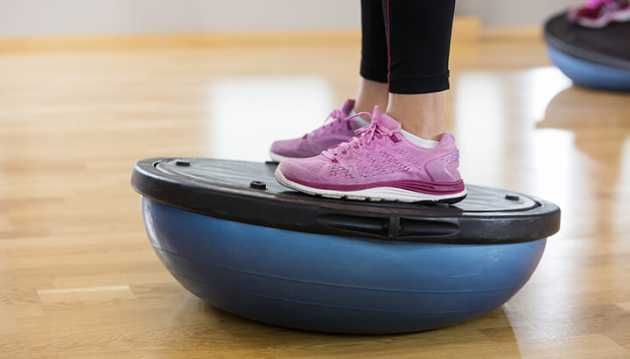If you’ve seen people at your local gym bouncing around on what appears to be half of an exercise ball, you have been introduced to the BOSU ball. Though it may look strange, this fitness device is a fun and effective addition to many types of workouts.
The “BOSU” in BOSU ball stands for “both sides up,” or alternately, “both sides utilized.” It was invented in 1999 by David Weck, and today, it’s part of many people’s regular workout routines. If you haven’t seen one, a BOSU ball is basically a semi-sphere, with a rubber bouncy ball top and a flat bottom. Exercises can be performed on both sides, hence the “both sides up” acronym.
Using the BOSU ball can add some core strengthening oomph to your workout, as your body has to work harder to balance itself than on a stationary surface. This can also help you to burn more calories. When the ball is turned flat side up, it can be great for improving balance. Developing balance and stability is crucial to overall musculoskeletal health in a number of ways and can help prevent injury.
How can half of a bouncy ball have these benefits, you ask? The following offers a little more on the function and research on the BOSU ball.
Improve your balance
Turning a BOSU ball flat side up creates an unstable, wobbly platform. Standing on this platform necessitates your body to use your stabilizing muscles, thereby improving your balance. Once you learn to stand on a BOSU ball without wobbling, you can do more intense balance exercises, such as knee lifts and yoga poses, to improve your balance further.
Having a strong center of balance is important for everyone, but it can be especially important for elderly people. Senior citizens are at a high risk of falls and using a BOSU ball to improve balance (holding onto a wall or nearby chair, if needed), may help to reduce falling risk, and therefore, the risk of injury.
Balance exercises, which maintain a strong, stable core, can also help us to avoid other types of injuries. One of these is injuries from biking. The authors of a 2010 study published in the journal Current Sports Medicine Reports wrote:
“Because of the nature of the bicycling position, the neck and back are at risk for injury. One method to prevent these injuries is to ensure that the body’s “core” is strong and stable. A strong and stable core also provides a platform to maximize power transfer, improving performance. Core exercises also may enhance recovery from intense bicycling efforts. Simple stability exercises can improve performance and may prevent injuries in bicyclists.”
A useful rehabilitation tool
Along with helping you to develop and maintain balance, using a BOSU ball may help with rehabilitation from certain musculoskeletal injuries. This is because doing exercises on an unstable surface can lead to lessened load on the joints themselves. As the authors of a 2013 study published in the Journal of Strength and Conditioning Research explained:
“… unstable surfaces in the squat may be beneficial in rehabilitation… because similar muscle activity can be achieved with reduced loads.”
Another study, published in 2013 in the CHEST Journal, the official publication of the American College of Chest Physicians, found that balance training could help improve the health of COPD patients when coupled with a pulmonary rehabilitation program. On the results of their study, the authors wrote:
“Our results support the feasibility and effectiveness of balance training as part of PR [pulmonary rehabilitation] for improving balance performance, muscle strength and self-reported physical function in patients with moderate to severe COPD.”
Enhance your overall workout
Even if you have excellent balance, and are not recovering from any injury or chronic condition, the BOSU ball is a great tool to have around. For one, it can make workouts more fun! There is something about jumping up and down on a bouncy rubber ball that brings out the inner child and having fun while getting a great cardio workout is ideal. Along with jumping, you can use the ball to do burpees, step-ups and more.
Many strength training exercises can also be performed on a BOSU ball. Strength training is a highly important part of physical fitness. Just cardio alone isn’t enough; strength training (also known as resistance training) is crucial, especially for older individuals. Just a few of the strength training exercises you can do with the help of a BOSU ball include:
- Squats
- Pushups
- Planks
- Lunges
- Crunches
- Barbell exercises
Activate your core muscles
The BOSU ball is an ideal way to activate your core muscles. A 2007 study published in the Journal of Strength and Conditioning Research tested the effectiveness of unstable surfaces on the activation of core muscles “during dynamic multijoint movement.” This study focused specifically on volunteers performing bench press exercises. On their results, the authors wrote:
“ …performing the bench press in a progressively unstable environment may be an effective method to increase activation of the core stabilizing musculature, while the upper- and lower-body stabilizers can be activated differentially depending on the mode of instability.”
You can also use your BOSU ball to stretch your muscles. It provides a great incline on which to rest your legs, arms or torso during a stretch. You can get a full workout by doing some stretches, then some cardio, then some strength exercises… all on your BOSU ball.
If you’re looking for a fun new way to amp up your workout routine, consider getting one of these fitness tools for your home. You can even take it outside in the warmer months to get a fun workout in the fresh air!
Ready to get started? Check out the following video for some basic beginner BOSU ball exercises. If you need more, just Google instructional videos.
Have you ever used a BOSU ball? Please tell us about your experience! Would you recommend one to your friends?
— Tanya Mead

